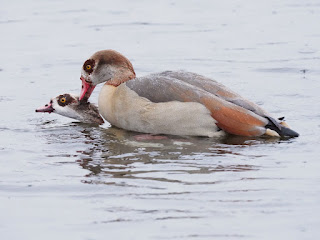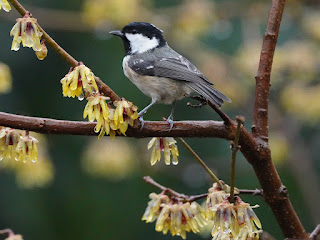I had wrongly supposed that the upper Grey Heron nest in the middle of the island, where a bird had been sitting, was abandoned. It wasn't: the chicks had hatched so no more sitting was needed and the parents could keep an eye on the nest from a neighbouring tree.
You have to listen quite carefully from 15 seconds on in this video to hear the faint clicking of very young Grey Heron chicks clashing their bills in the nest, a signal that they want to be fed. It will get louder as they grow. This is the earliest heron brood I've ever seen in the park. Assuming that the chicks are already three or four days old, the parents would have started incubating the eggs in the first week of December.
There were other signs of early activity. A pair of Mute Swans at the island were mirroring each other's movements and picking up leaves, a sign that they are thinking of nesting. It's very early so they may not be serious yet, but I also saw other pairs displaying to each other.
However, this pair were not the regular island residents. These soon arrived on the scene, with the male climbing with some difficulty over a wire basket, and the intruders were chased off. The male of the island pair is big and tough and the number two swan in the ranking order, the only swan who can keep the killer male at bay.
It can't be much fun being a female Egyptian Goose.
On a wet day, with few people in the park, the Canada Geese felt safe enough to come ashore and crop the rich grass where the site of the Olympic grandstand of 2012 was relaid with expensive sports turf.
More Canadas stood on the landing stage, to the obvious resentment of the Black-Headed Gull who owns the territory.
When it's raining you can see darker trails across the lake. I think these are where a powerboat has passed. Outboard motors are cooled by pumping water through the engine, and when this comes out it's slightly oily.
Wet days are often good for seeing the smaller birds. A Wren was hopping around on a pile of cut undergrowth in the woodland at the foot of Buck Hill.
There was a young male Blackbird in the Rose Garden shrubbery. The resident pair had bred last summer but the young ones soon became as furtive as the adults, and this is the first time I've seen a young Blackbird here since then.
Also present were the Chaffinch pair ...
... one of the Blue Tits ...
... and the Coal Tit, as usual very shy and hard to photograph.
This Coal Tit at Mount Gate is much bolder, and posed obligingly in a wintersweet bush. It knows it will be fed if it stays around.
So does this Blue Tit.
A Jay had already had one peanut but wanted another.
Tom was at Rainham Marshes yesterday when the weather was brighter, and got fine pictures of a male Bearded Tit clinging to a reed ...
... and a very tame Pheasant.













%202025%201a.jpg)
%202025%201a.jpg)
Hello Ralph,
ReplyDeletethe Canadas standing on the landing stage are a family whose chicks hatched last year in early May. It's two adults and 3 now adult chicks. The parents will probably start chasing them away by February/March but at the moment they are still closely bonded. The landing stage is currently their little hub.
Jenna
Thank you. I will keep an eye on them and see what happens. The gull, of course, will always strut around his space, but there is nothing he can do about big geese.
DeleteI guess they know what they are doing. It gives them some safety from dogs and a good vantage point in case someone was feeding on either side of the lake, particularly the Triangle.
DeleteJenna
Yes indeed. One of the best locations in the park as long as you don't have a pressing need to feed. And even then, the gates of the Diana drain are locked in the evening so they can fly over in complete safety -- even the fox that was there seems to be gone.
DeleteAmazing that we have Heron chicks by the first week of January. I suppose they know what they're doing.
ReplyDeleteWe saw wo Grebes displaying to each other today. One was still in winter plumage, the other one was getting its breeding finery.
Tinúviel
I expect that the Battersea Park herons will be at about this stage. They all breed in synchrony, something that I think happens when there are enough of them but we haven't reached that number yet though the little colony is growing.
DeleteGrebes don't seem to mind if their mates are still in their winter plumage, and are happy to display and even dance when the mood takes them.
Hey Ralph / Jenna :^D
ReplyDeleteBit late to yesterday's blog...nice to see Freddie and family (the Canadas) and Bob together on the landing stage (We named the gull on the landing stage Bob a while ago, as it's quicker than saying the "Black-headed Gull who owns the landing stage" and all the favourites end up with nicknames anyway!)
Great news about the herons - decided to make a new year's resolution to carry my camera with me in future, so hopefully catch sight of them at some point.
The Island Cob (4FYG) is a tough old bird - as Jenna knows, a while back his left eye was shut for a couple of days and he lost sight in it; on a recent visit I noticed that he had regained sight in that eye, but would have been blind from it for a good few months. That pair's territory is between the boathouses and the boat hire; he leaves the little flock by the Dell restaurant in peace, and he has an uneasy truce with the Lido Cob (4DTP) - that pair have the area between the Lido / Boathouses and the Landing Stage / Triangle Car Park. The Long Water Cob and family do come as far as the Landing Stage / Triangle as people feed there - 4DTP tolerates that, but if they try to come any further onto the Serpentine he (now with the help of his cygnet!) warns them back - mentioned on the blog a while back that the Long Water Cob lost a huge fight to 4DTP, so he and his family return to the Long Water if they see they've upset 4DTP...
Jon
Many thanks for all this information. It's good to know what's happening in this long war of the swans.
Delete